Effect of the Morphology of Tungsten Oxide Embedded in Sodium Alginate/Polyvinylpyrrolidone Composite Beads on the Photocatalytic Degradation of Methylene Blue Dye Solution
Abstract
1. Introduction
2. Materials and Methods
2.1. Materials
2.2. Preparation of WO3 Nanostructures
2.3. Preparation of Adsorbent Beads
2.4. Characterization of the WO3 Nanostructures and Polymeric Beads
2.5. Photocatalytic Decay Experiments
2.6. Kinetic Models
3. Results and Discussion
3.1. Characterization of the SA/PVP/WO3 Nanocomposite
3.2. Adsorption and Photocatalysis Removal of Methylene Blue
3.2.1. Effect of Time on MB Decay
3.2.2. Effect of the Light Intensity on the MB Photocatalytic Decay
3.2.3. Effect of Initial Dye Concentration on MB Photocatalytic Decay
3.2.4. Effect of WO3 concentration in SA/PVP matrix
3.3. Analysis of the Reaction Kinetics and Proposed Mechanism
3.3.1. Kinetic Models
3.3.2. Proposed Reaction Mechanism of SA/PVP/WO3 Nanocomposite with MB
3.4. Recycling of SA/PVP/WO3 Nanocomposite
4. Conclusions
Supplementary Materials
Author Contributions
Funding
Conflicts of Interest
References
- Vijayaraghavan, K.; Yun, Y.S. Biosorption of C.I. reactive black 5 from aqueous solution using acid treated biomass of brown seaweed Laminaria sp. Dye. Pigment. 2008, 76, 726–732. [Google Scholar] [CrossRef]
- Aksu, Z. Application of biosorption for the removal of organic pollutants: A review. Process. Biochem. 2005, 40, 997–1026. [Google Scholar] [CrossRef]
- Sadettin, S.; Donmez, G. Bioaccumulation of reactive dyes by thermophilic cyanobacteria. Process. Biochem. 2006, 41, 836–841. [Google Scholar] [CrossRef]
- Aksu, Z.; Tezer, S. Biosorption of reactive dyes on the green alga Chlorella vulgaris. Process. Biochem. 2005, 40, 1347–1361. [Google Scholar] [CrossRef]
- Guibal, E.; Roussy, J. Coagulation and flocculation of dye-containing solutions using a biopolymer (Chitosan). React. Funct. Polym. 2007, 67, 33–42. [Google Scholar] [CrossRef]
- Salama, A.; Mohamed, A.; Aboamera, N.M.; Osman, T.A.; Khattab, A. Photocatalytic degradation of organic dyes using composite nanofibers under UV irradiation. Appl. Nanosci. 2018, 8, 155–161. [Google Scholar] [CrossRef]
- Mohy Eldin, M.S.; Gouda, M.H.; Abu-Saied, M.A.; Youssef, M.E.; El-Shazly, Y.M.S.; Farag., H.A. Removal of methylene blue by amidoxime polyacrylonitrile-grafted cotton fabrics: Kinetic, equilibrium, and simulation studies. Fiber. Polym. 2016, 17, 1884–1897. [Google Scholar] [CrossRef]
- El Essawy, N.A.; Ali, S.M.; Farag, H.A.; Konsowa, A.H.; Elnouby, M.; Hamad, H.A. Green synthesis of graphene from recycled PET bottle wastes for use in the adsorption of dyes in aqueous solution. Ecotoxicol. Environ. Saf. 2017, 145, 57–68. [Google Scholar] [CrossRef]
- Sarkar, S.; Chakraborty, S.; Bhattacharjee, C. Photocatalytic degradation of pharmaceutical wastes by alginate supported TiO2 nanoparticles in packed bed photoreactor (PBPR). Ecotoxicol. Environ. Saf. 2015, 121, 263–270. [Google Scholar] [CrossRef]
- Kanakaraju, D.; Ravichandar, S.; Lim, Y.C. Combined effects of adsorption and photocatalysis by hybrid TiO2/ZnO-calcium alginate beads for the removal of copper. J. Environ. Sci. 2017, 55, 214–223. [Google Scholar] [CrossRef]
- Tie, L.; Yu, C.; Zhao, Y.; Chen, H.; Yang, S.; Sun, J.; Dong, S.; Sun, J. Fabrication of WO3 nanorods on reduced graphene oxide sheets with augmented visible light photocatalytic activity for efficient mineralization of dye. J. Alloys Compd. 2018, 769, 83–91. [Google Scholar] [CrossRef]
- Singh, J.; Kaur, H.; Rawat, M. A novel green approach for the synthesis of tungsten oxide nanorods and its efficient potential towards photocatalytic degradation of reactive green 19 dye. J. Mater. Sci. Mater. Electron. 2018, 29, 13715–13722. [Google Scholar] [CrossRef]
- Kim, H.; Senthil, K.; Yong, K. Photoelectrochemical and photocatalytic properties of tungsten oxide nanorods grown by thermal evaporation. Mater. Chem. Phys. 2010, 120, 452–455. [Google Scholar] [CrossRef]
- DePuccio, D.P.; Botella, P.; O’Rourke, B.; Landry, C.C. Degradation of methylene blue using porous WO3, SiO2–WO3, and their Au-loaded analogs: Adsorption and photocatalytic studies. Acs Appl. Mater. Interfaces 2015, 7, 1987–1996. [Google Scholar] [CrossRef]
- Yassin, A.M.; Elnouby, M.; El-Deeb, N.M.; Hafez, E.E. Tungsten oxide nanoplates; the novelty in targeting metalloproteinase-7 gene in both cervix and colon cancer cells. Appl. Biochem. Biotechnol. 2016, 180, 623–637. [Google Scholar] [CrossRef] [PubMed]
- Singh, S.; Srivastava, V.C.; Lo, S.L. Surface modification or doping of WO3 for enhancing the photocatalytic degradation of organic pollutant containing wastewaters: A review. Mater. Sci. Forum 2016, 855, 105–126. [Google Scholar] [CrossRef]
- Jeevitha, G.; Abhinayaa, R.; Mangalaraj, D.; Ponpandian, N. Tungsten oxide-graphene oxide (WO3-GO) nanocomposite as an efficient photocatalyst, antibacterial and anticancer agent. J. Phys. Chem. Solids 2018, 116, 137–147. [Google Scholar] [CrossRef]
- Ma, X.; Ma, W.; Jiang, D.; Li, D.; Meng, S.; Chen, M. Construction of novel WO3/SnNb2O6 hybrid nanosheet heterojunctions as efficient Z-scheme photocatalysts for pollutant degradation. J. Colloid Interface Sci. 2017, 506, 93–101. [Google Scholar] [CrossRef]
- Ke, J.; Zhou, H.; Liu, J.; Duan, X.; Zhang, H.; Liu, S.; Wang, S. Crystal transformation of 2D tungstic acid H2WO4 to WO3 for enhanced photocatalytic water oxidation. J. Colloid Interface Sci. 2018, 514, 576–583. [Google Scholar] [CrossRef]
- Zhang, L.J.; Li, S.; Liu, B.K.; Wang, D.J.; Xie, T.F. Highly efficient CdS/WO3 photocatalysts: Z-scheme photocatalytic mechanism for their enhanced photocatalytic H2 evolution under visible light. ACS Catal. 2014, 4, 3724–3729. [Google Scholar] [CrossRef]
- Naji, H.K.; Oda, A.M.; Abdulaljeleel, W.; Abdilkadhim, H.; Hefdhi, R. ZNO-Ag/PS and ZnO/PS films for photocatalytic degradation of methylene blue. Indones. J. Chem. 2020, 20, 314–323. [Google Scholar] [CrossRef]
- Albarelli, J.Q.; Santos, D.T.; Murphy, S.; Oelgemoller, M. Use of Ca–alginate as a novel support for TiO2 immobilization in methylene blue decolorisation. Water Sci. Technol. 2009, 60, 1081–1087. [Google Scholar] [CrossRef] [PubMed]
- Babu., V.R.; Sairam, M.; Hosamani, K.M.; Aminabhavi, T.M. Preparation of sodium alginate–methylcellulose blend microspheres for controlled release of nifedipine. Carbohydr. Polym. 2007, 69, 241–250. [Google Scholar] [CrossRef]
- Akamatsu, K.; Maruyama, K.; Chen, W.; Nakao, A.; Nakao, S. Drastic difference in porous structure of calcium alginate microspheres prepared with fresh or hydrolyzed sodium alginate. J. Colloid Interface Sci. 2011, 363, 707–710. [Google Scholar] [CrossRef]
- Bhattacharyya, R.; Ray, S.K. Adsorption of industrial dyes by semi-IPN hydrogels of acrylic copolymers and sodium alginate. J. Ind. Eng. Chem. 2015, 22, 92–102. [Google Scholar] [CrossRef]
- Gouda, M.H.; Gouveia, W.; Afonso, M.L.; Šljukić, B.; El Essawy, N.A.; Nassr, A.B.A.A.; Santos, D.M.F. Poly(vinyl alcohol)-based crosslinked ternary polymer blend doped with sulfonated graphene oxide as a sustainable composite membrane for direct borohydride fuel cells. J. Power Sources 2019, 432, 92–101. [Google Scholar] [CrossRef]
- Habib, M.A.; Shahadat, M.T.; Bahadur, N.M.; Ismail, I.M.I.; Mahmood, A.J. Synthesis and characterization of ZnO-TiO2 nanocomposites and their application as photocatalyst. Int. Nano Lett. 2013, 3, 5. [Google Scholar] [CrossRef]
- Elkady, M.F.; Hassan, H.S.; Salama, E. Sorption profile of phosphorus ions onto ZnO nanorods synthesized via sonic technique. J. Eng. 2016, 2016, 1–9. [Google Scholar] [CrossRef]
- Liang, Y.C.; Chang, C.W. Preparation of orthorhombic WO3 thin films and their crystal quality-dependent dye photodegradation ability. Coatings 2019, 9, 90. [Google Scholar] [CrossRef]
- Han, B.; Popov, A.L.; Shekunova, T.O.; Kozlov, D.A.; Ivanova, O.S.; Rumyantsev, A.A.; Shcherbakov, A.B.; Popova, N.R.; Baranchikov, A.E.; Ivanov, V.K. Highly crystalline WO3 nanoparticles are nontoxic to stem cells and cancer cells. J. Nanomater. 2019, 2019, 1–13. [Google Scholar] [CrossRef]
- Paula, B.; Sharma, S.; Purkayastha, D.D.; Dhar, S.S.; Bal, R. Facile synthesis of size-controlled Ag supported on WO3 nanorods and their application as novel and active catalyst in oxidant-free dehydrogenation of benzyl alcohols. Catal. Commun. 2019, 132, 105804. [Google Scholar] [CrossRef]
- Soliman, H.M.A.; Kashyout, A.B.; El Nouby, M.S.; Abosehly, A.M. Effect of hydrogen peroxide and oxalic acid on electrochromic nanostructured tungsten oxide thin films. Int. J. Electrochem. Sci. 2012, 7, 258–271. [Google Scholar]
- Li, K.; Zhu, J.; Guan, G.; Wu, H. Preparation of chitosan-sodium alginate films through layer-by-layer assembly and ferulic acid crosslinking: Film properties, characterization, and formation mechanism. Int. J. Biol. Macromol. 2019, 122, 485–498. [Google Scholar] [CrossRef] [PubMed]
- Ebrahimi, R.; Maleki, A.; Zandsalimi, Y.; Ghanbari, R.; Shahmoradi, B.; Rezaee, R.; Safari, M.; Joo, S.W.; Daraei, H.; Puttaiah, S.H.; et al. Photocatalytic degradation of organic dyes using WO3-doped ZnO nanoparticles fixed on a glass surface in aqueous solution. J. Ind. Eng. Chem. 2019, 73, 297–305. [Google Scholar] [CrossRef]
- Şahin, Ö.; Kaya, M.; Saka, C. Plasma-surface modification on bentonite clay to improve the performance of adsorption of methylene blue. Appl. Clay Sci. 2015, 116, 46–53. [Google Scholar] [CrossRef]
- Dutta, D.; Thakur, D.; Bahadur, D. SnO2 quantum dots decorated silica nanoparticles for fast removal of cationic dye (methylene blue) from wastewater. Chem. Eng. J. 2015, 281, 482–490. [Google Scholar] [CrossRef]
- Abdelrahman, E.A.; Hegazey, R.M.; Kotp, Y.H.; Alharbi, A. Facile synthesis of Fe2O3 nanoparticles from Egyptian insecticide cans for efficient photocatalytic degradation of methylene blue and crystal violet dyes. Spectrochim. Acta A Mol. Biomol. Spectrosc. 2019, 222, 117195. [Google Scholar] [CrossRef]
- Abdelrahman, E.A.; Hegazey, R.M. Facile synthesis of HgO nanoparticles using hydrothermal method for efficient photocatalytic degradation of crystal violet dye under UV and sunlight irradiation. J. Inorg. Organomet. Polym. Mater. 2019, 29, 346–358. [Google Scholar] [CrossRef]
- Nassar, M.Y.; Aly, H.M.; Abdelrahman, E.A.; Moustafa, M.E. Synthesis, characterization, and biological activity of some novel Schiff bases and their Co(II) and Ni(II) complexes: A new route for Co3O4 and NiO nanoparticles for photocatalytic degradation of methylene blue dye. J. Mol. Struct. 2017, 1143, 462–471. [Google Scholar] [CrossRef]
- Yang, Y.; Zhang, C.; Huang, D.; Zeng, G.; Huang, J.; Lai, C.; Xiong, W. Boron nitride quantum dots decorated ultrathin porous g-C3N4: Intensified exciton dissociation and charge transfer for promoting visible-light-driven molecular oxygen activation. Appl. Catal. B 2019, 245, 87–99. [Google Scholar] [CrossRef]
- Liu, Z.; Liu, R.; Yi, Y.; Han, W.; Kong, F.; Wang, S. Photocatalytic degradation of dyes over a xylan/PVA/TiO2 composite under visible light irradiation. Carbohydr. Polym. 2019, 223, 115081. [Google Scholar] [CrossRef] [PubMed]
- Li, Y.; Tang, Z.; Zhang, J.; Zhang, Z. Enhanced photocatalytic performance of tungsten oxide through tuning exposed facets and introducing oxygen vacancies. J. Alloy. Compd. 2017, 708, 358–366. [Google Scholar] [CrossRef]
- Liu, S.; Tang, W.; Chou, P. Microwave-assisted synthesis of triple 2D g-C3N4/Bi2WO6/rGO composites for ibuprofen photodegradation: Kinetics, mechanism and toxicity evaluation of degradation products. Chem. Eng. J. 2020, 387, 124098. [Google Scholar] [CrossRef]
- Bhavsar, K.S.; Labhane, P.K.; Dhake, R.B.; Sonawane, G.H. Solvothermal synthesis of activated carbon loaded CdS nanoflowers: Boosted photodegradation of dye by adsorption and photocatalysis synergy. Chem. Phys. Lett. 2020, 744, 137202. [Google Scholar] [CrossRef]
- Liu, S.; Lin, W.A. Simple method to prepare g-C3N4-TiO2/waste zeolites as visible-light responsive photocatalytic coatings for degradation of indoor formaldehyde. J. Hazard. Mater. 2019, 368, 468–476. [Google Scholar] [CrossRef]
- Ismail, A.A.; Faisal, M.; Al-Haddad, A. Mesoporous WO-graphene photocatalyst for photocatalytic degradation of methylene blue dye under visible light illumination. J. Environ. Sci. 2018, 66, 328–337. [Google Scholar] [CrossRef]
- Ahmed, B.; Kumar, S.; Ojha, A.K.; Donfack, P.; Materny, A. Facile and controlled synthesis of aligned WO3 nanorods and nanosheets as an efficient photocatalyst material. Spectrochim. Acta A Mol. Biomol. Spectrosc. 2017, 175, 250–261. [Google Scholar] [CrossRef]
- Abdullah, M.A.; Chong, F.K. Preparation and characterization of tungsten-loaded titanium dioxide photocatalyst for enhanced dye degradation. J. Hazard. Mater. 2010, 176, 451–458. [Google Scholar]
- Yan, X.; Zong, X.; Lu, G.; Wang, L. Ordered mesoporous tungsten oxide and titanium oxide composites and their photocatalytic degradation behavior. Prog. Nat. Sci. Mater. Int. 2012, 22, 654–660. [Google Scholar] [CrossRef]
- Saleha, T.A.; Gupta, V.K. Functionalization of tungsten oxide into MWCNT and its application for sunlight-induced degradation of rhodamine B. J. Colloid Interf. Sci. 2011, 362, 337–344. [Google Scholar] [CrossRef]
- Senthil, R.A.; Priya, A.; Theerthagiri, J.; Selvi, A.; Nithyadharseni, P.; Madhavan, J. Facile synthesis of α-Fe2O3/WO3 composite with an enhanced photocatalytic and photo-electrochemical performance. Ionics 2018, 24, 3673–3684. [Google Scholar] [CrossRef]
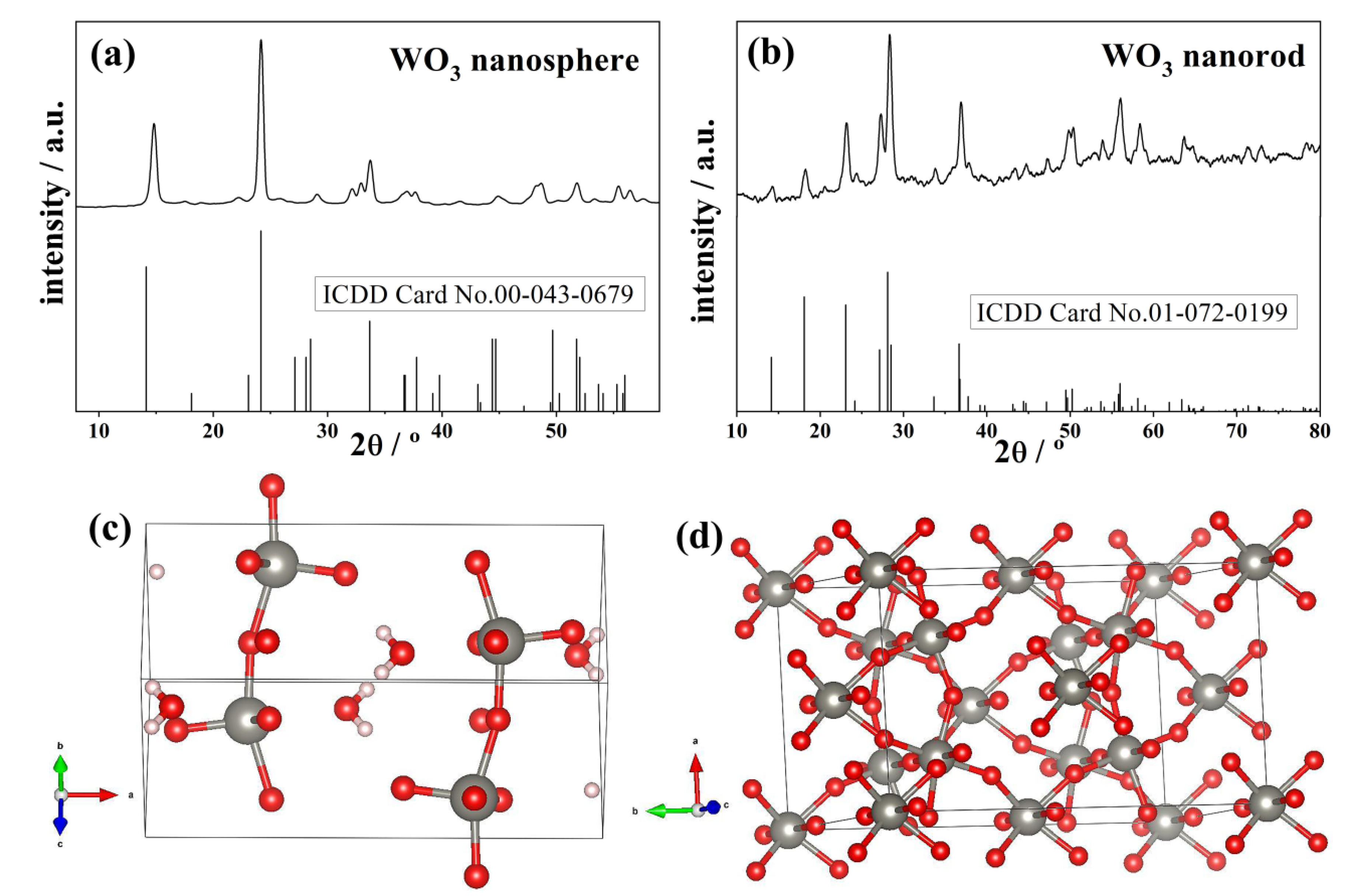

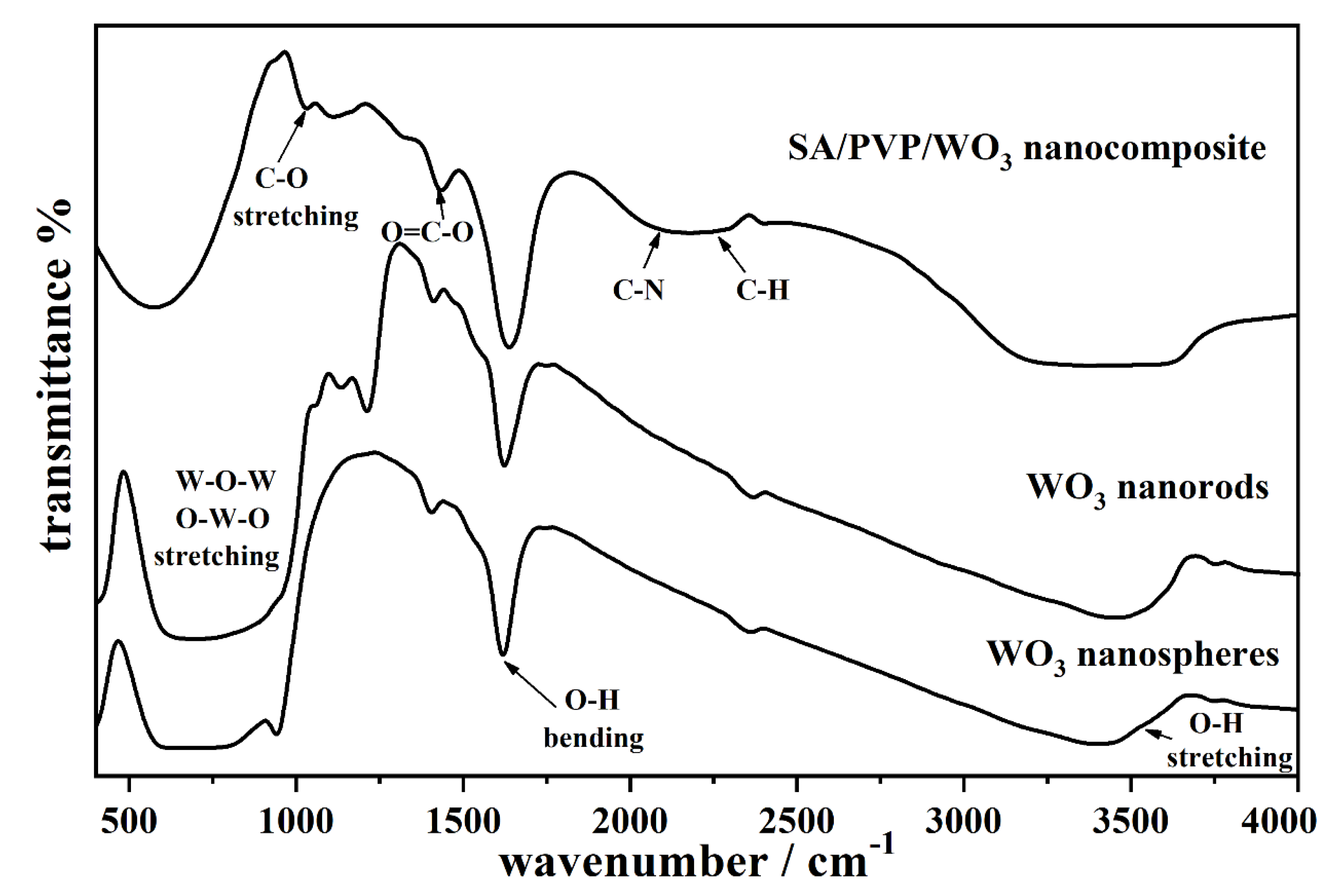
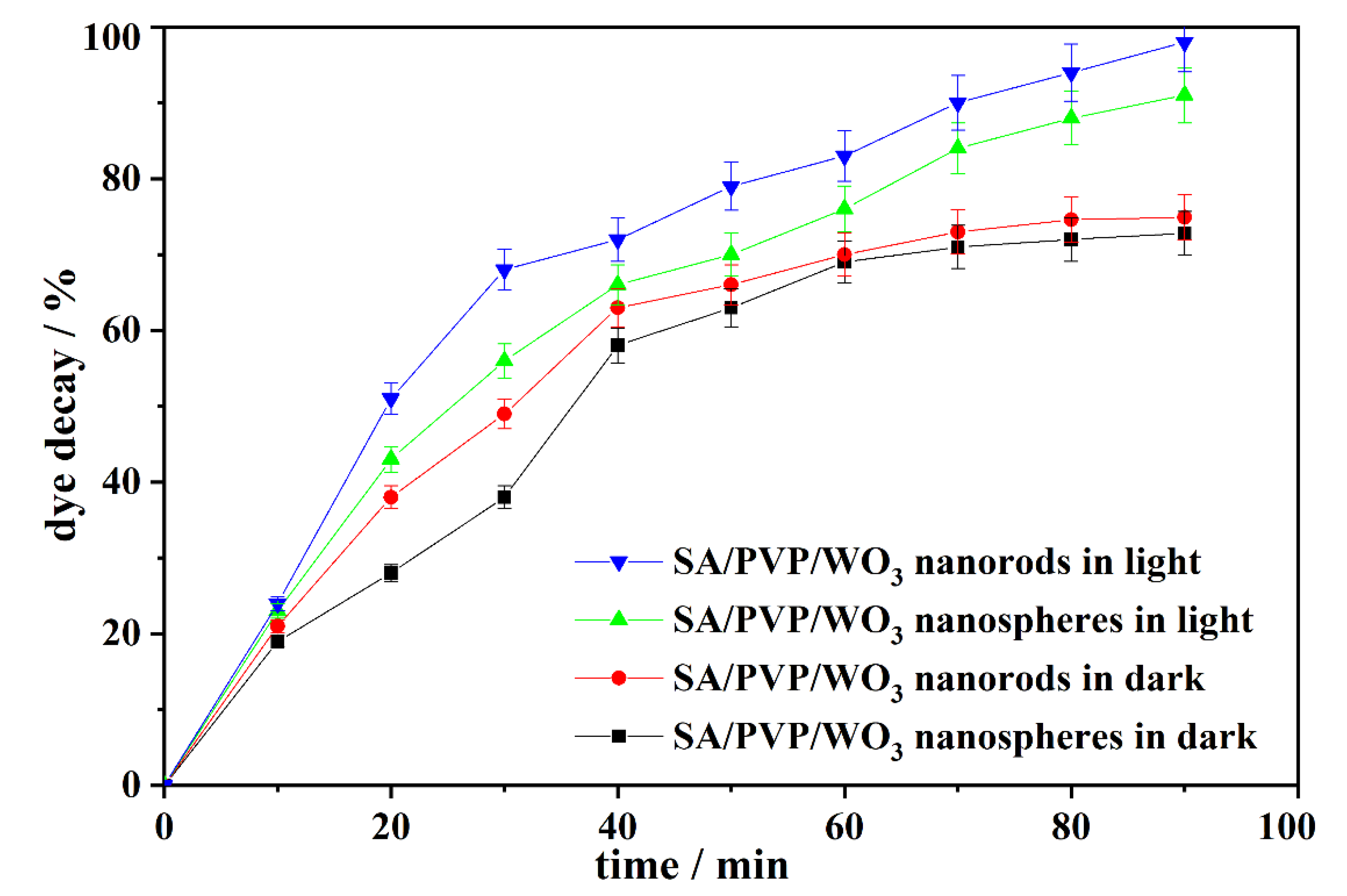
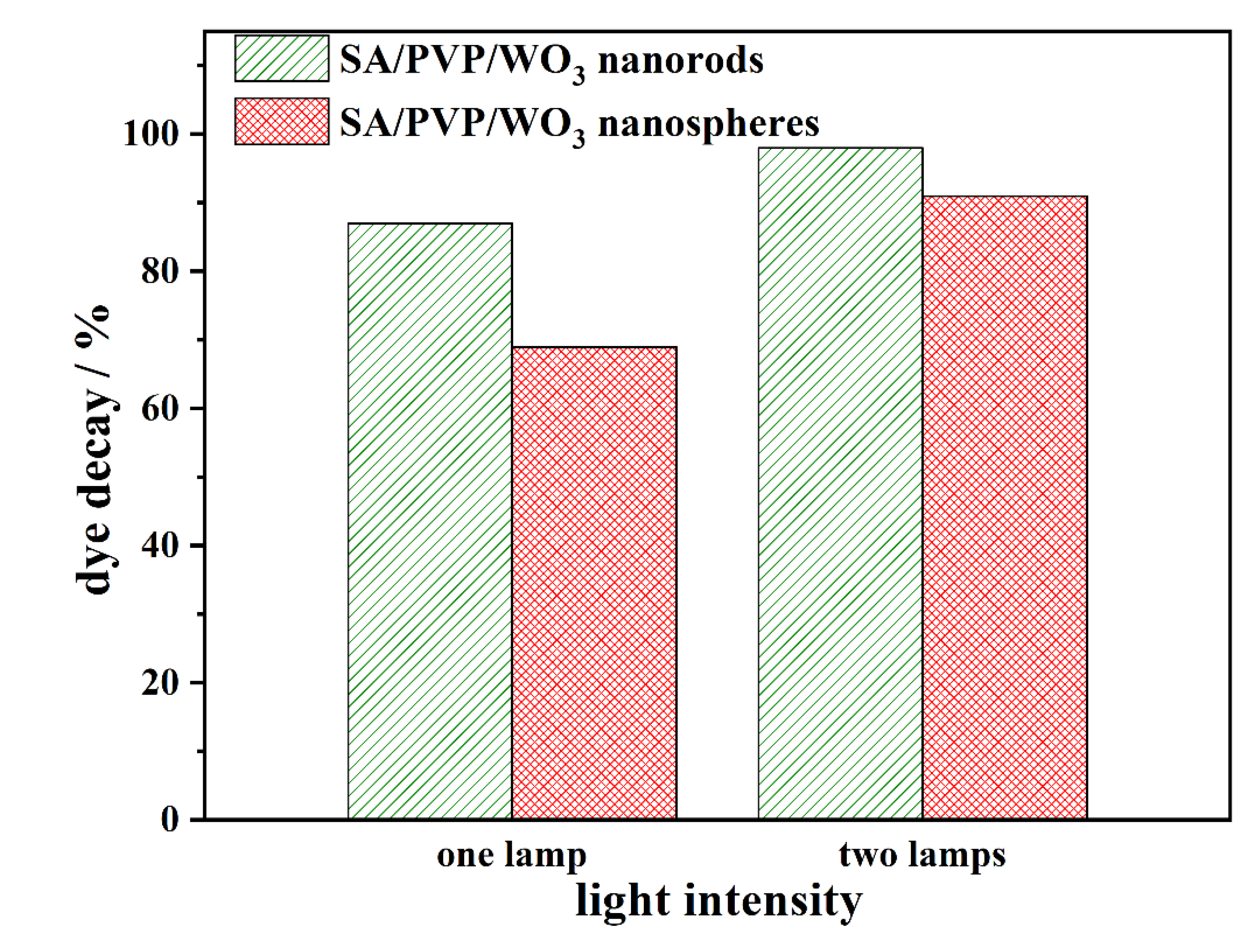
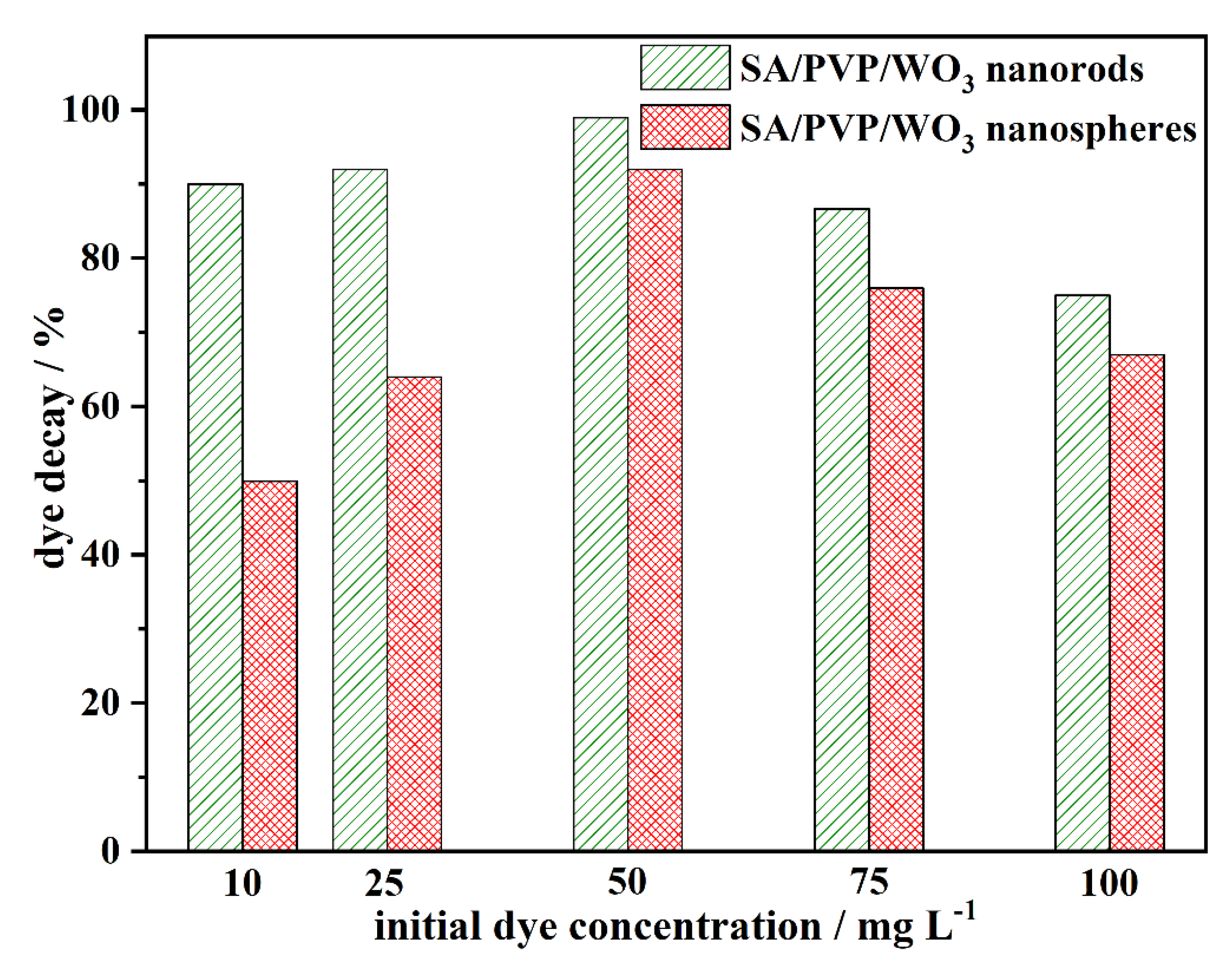
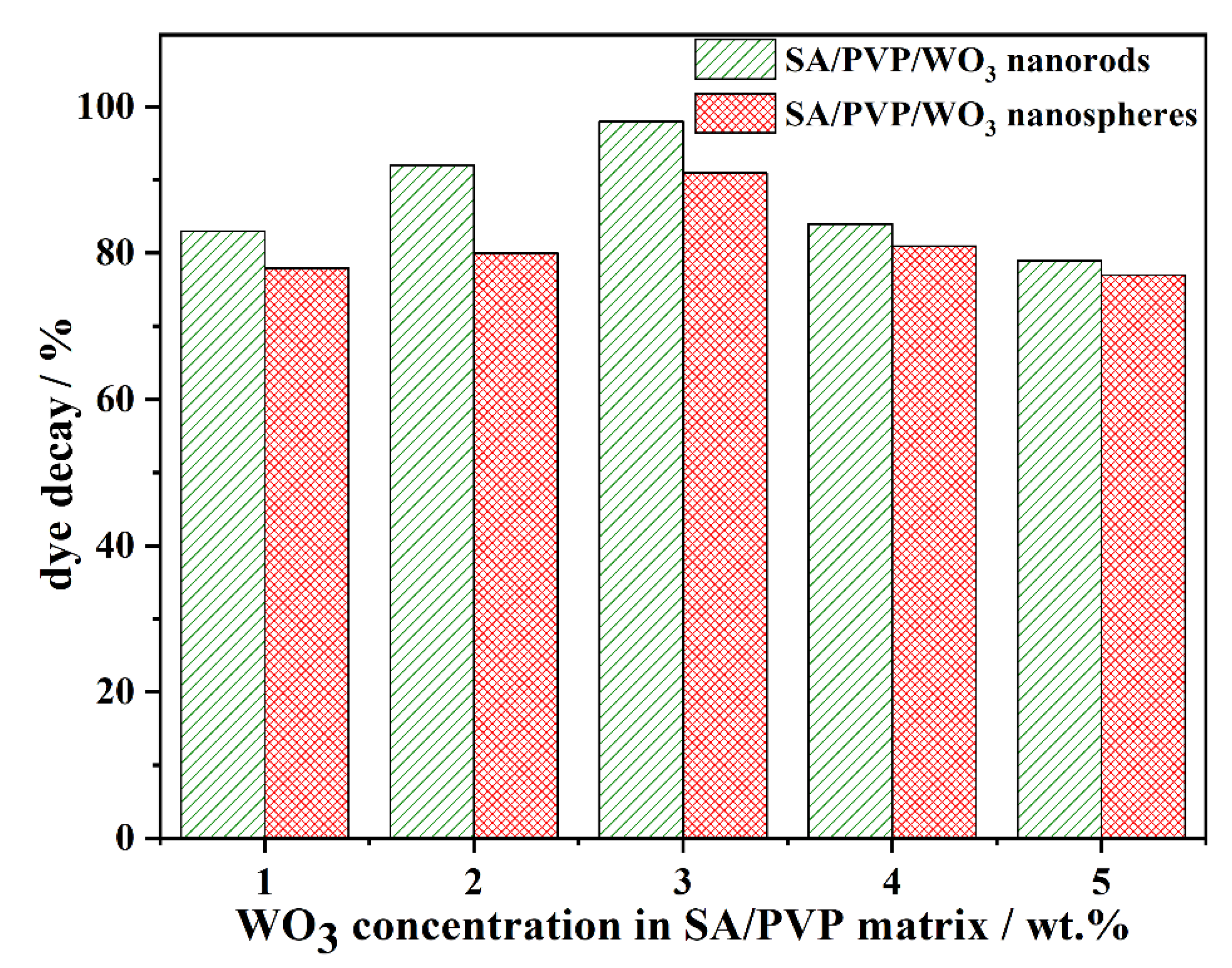
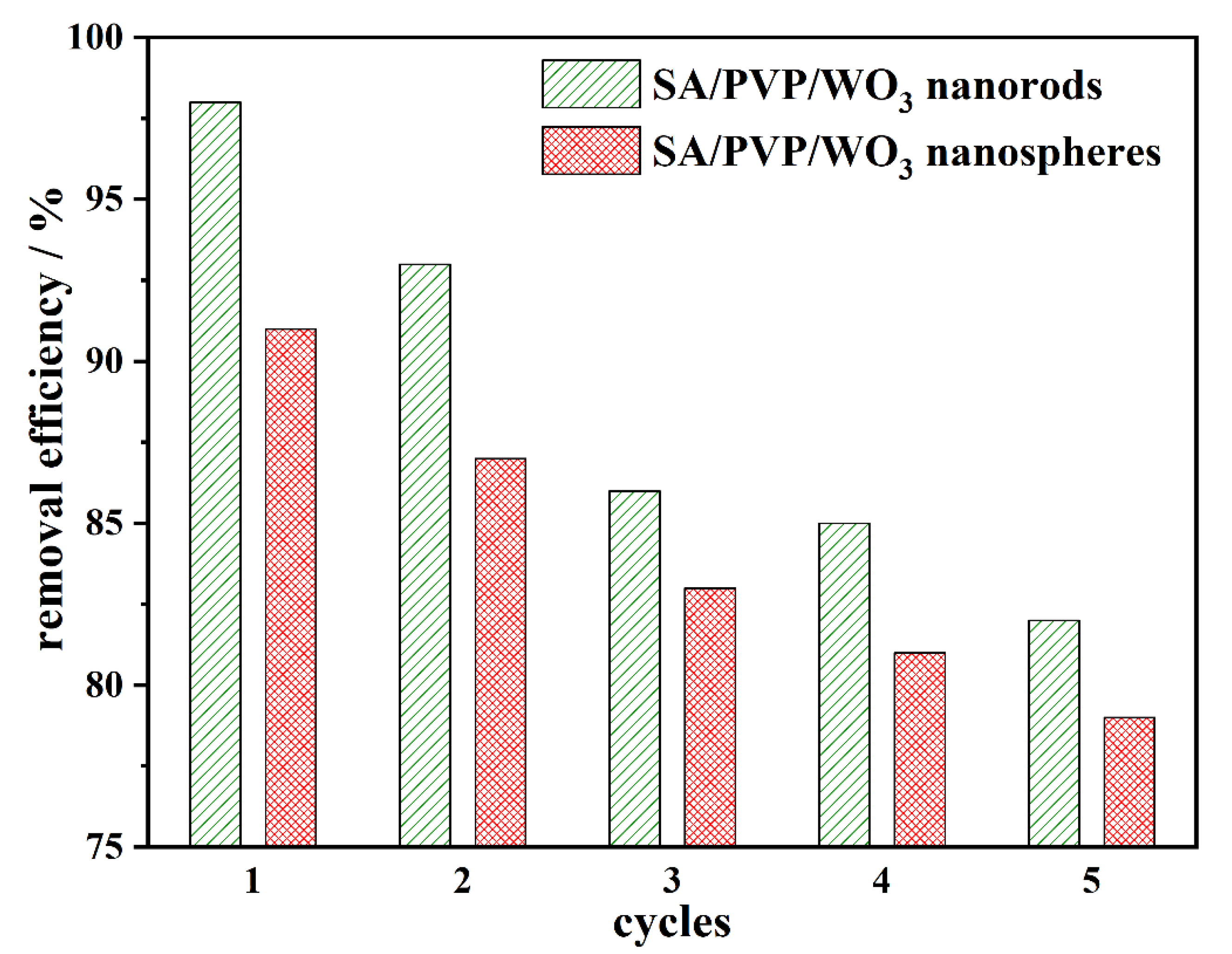
| Nanocomposite Material | Pseudo-First-Order | Pseudo-Second-Order | |||
|---|---|---|---|---|---|
| qe mg g−1 | K1 sec−1 | R2 | K2 g mg−1 s−1 | R2 | |
| SA/PVP/WO3 Sphere Nanocomposite in Dark | 72.8 | 0.057 | 0.954 | 0.000398238 | 0.902 |
| SA/PVP/WO3 Rods Nanocomposite in Dark | 74.9 | 0.062 | 0.920 | 0.000533691 | 0.979 |
| SA/PVP/WO3 Sphere Nanocomposite in Light | 91.0 | 0.039 | 0.948 | 0.000358546 | 0.992 |
| SA/PVP/WO3 Rods Nanocomposite in Light | 98.0 | 0.037 | 0.973 | 0.000368839 | 0.973 |
| Materials | Structure | Morphology | Dye | Efficiency | Ref. |
|---|---|---|---|---|---|
| tungsten oxide embedded in sodium alginate/polyvinylpyrrolidone composite beads | orthorhombic crystalline WO3 | spherical, nanorods | MB | up to 98% | current work |
| aligned WO3 | triclinic, orthorhombic and monoclinic | nanorods and nanosheets | MB | up to 94% | [47] |
| tungsten-loaded TiO2 | crystalline WO3 at higher loadings (>12 mol%) | aggregation | MB | 90% | [48] |
| mesoporous WO3/TiO2 | crystalline | mesoporous | rhodamine B | up to 88% | [49] |
| MWCNT/WO3 | hexagonal and orthorhombic | aggregation | rhodamine B | up to 92% | [50] |
| α-Fe2O3/WO3 composite | crystalline | spherical-shaped α-Fe2O3 nanoparticles and WO3 nanorods | MB | up to 91% | [51] |
| tungsten oxide-graphene oxide (WO3-GO) | monoclinic | aggregation | MB | 97% | [17] |
| WO3 nanorods on reduced graphene oxide sheets | hexagonal wurtzite phase | flower-like | methylthionine chloride | 94% | [11] |
© 2020 by the authors. Licensee MDPI, Basel, Switzerland. This article is an open access article distributed under the terms and conditions of the Creative Commons Attribution (CC BY) license (http://creativecommons.org/licenses/by/4.0/).
Share and Cite
Elsayed, E.M.; S. Elnouby, M.; Gouda, M.H.; Elessawy, N.A.; Santos, D.M.F. Effect of the Morphology of Tungsten Oxide Embedded in Sodium Alginate/Polyvinylpyrrolidone Composite Beads on the Photocatalytic Degradation of Methylene Blue Dye Solution. Materials 2020, 13, 1905. https://doi.org/10.3390/ma13081905
Elsayed EM, S. Elnouby M, Gouda MH, Elessawy NA, Santos DMF. Effect of the Morphology of Tungsten Oxide Embedded in Sodium Alginate/Polyvinylpyrrolidone Composite Beads on the Photocatalytic Degradation of Methylene Blue Dye Solution. Materials. 2020; 13(8):1905. https://doi.org/10.3390/ma13081905
Chicago/Turabian StyleElsayed, Eman M., Mohamed S. Elnouby, M. H. Gouda, Noha A. Elessawy, and D. M. F. Santos. 2020. "Effect of the Morphology of Tungsten Oxide Embedded in Sodium Alginate/Polyvinylpyrrolidone Composite Beads on the Photocatalytic Degradation of Methylene Blue Dye Solution" Materials 13, no. 8: 1905. https://doi.org/10.3390/ma13081905
APA StyleElsayed, E. M., S. Elnouby, M., Gouda, M. H., Elessawy, N. A., & Santos, D. M. F. (2020). Effect of the Morphology of Tungsten Oxide Embedded in Sodium Alginate/Polyvinylpyrrolidone Composite Beads on the Photocatalytic Degradation of Methylene Blue Dye Solution. Materials, 13(8), 1905. https://doi.org/10.3390/ma13081905






